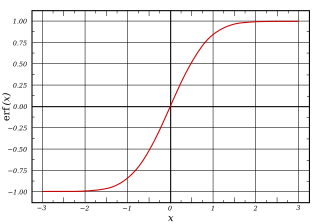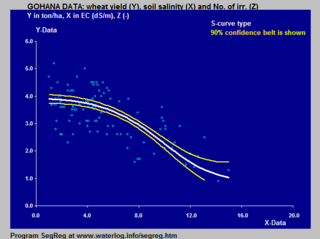Sigmoid function

A sigmoid function is any
A common example of a sigmoid function is the logistic function shown in the first figure and defined by the formula:[1]
Other standard sigmoid functions are given in the
Special cases of the sigmoid function include the
A wide variety of sigmoid functions including the logistic and
Definition
A sigmoid function is a bounded, differentiable, real function that is defined for all real input values and has a non-negative derivative at each point[1] [2] and exactly one inflection point.
Properties
In general, a sigmoid function is
A sigmoid function is constrained by a pair of
A sigmoid function is convex for values less than a particular point, and it is concave for values greater than that point: in many of the examples here, that point is 0.
Examples

- Logistic function
- Hyperbolic tangent(shifted and scaled version of the logistic function, above)
- Arctangent function
- Gudermannian function
- Error function
- Generalised logistic function
- Smoothstep function
- Some algebraic functions, for example
- and in a more general form[3]
- Up to shifts and scaling, many sigmoids are special cases of whereis the inverse of the negativeBox–Cox transformation, and and are shape parameters.[4]
- Smooth Interpolation[5] normalized to (-1,1) and is the slope at zero:
Applications

Many natural processes, such as those of complex system learning curves, exhibit a progression from small beginnings that accelerates and approaches a climax over time. When a specific mathematical model is lacking, a sigmoid function is often used.[6]
The van Genuchten–Gupta model is based on an inverted S-curve and applied to the response of crop yield to soil salinity.
Examples of the application of the logistic S-curve to the response of crop yield (wheat) to both the soil salinity and depth to water table in the soil are shown in modeling crop response in agriculture.
In
In
In
In computer graphics and real-time rendering, some of the sigmoid functions are used to blend colors or geometry between two values, smoothly and without visible seams or discontinuities.
The logistic function can be calculated efficiently by utilizing
See also
References
- ^ ISBN 978-3-540-59497-0.
- PMID 8125495.
- PMID 26707389.
- ^ "grex --- Growth-curve Explorer". GitHub. 2022-07-09. Archived from the original on 2022-08-25. Retrieved 2022-08-25.
- ^ EpsilonDelta (2022-08-16). "Smooth Transition Function in One Dimension | Smooth Transition Function Series Part 1". 13:29/14:04 – via www.youtube.com.
- S2CID 14456885.
- ISBN 978-0-9745607-2-4. Archivedfrom the original on 2022-07-14. Retrieved 2020-03-28.
- Gustafson, John L.; Yonemoto, Isaac (2017-06-12). "Beating Floating Point at its Own Game: Posit Arithmetic" (PDF). Archived(PDF) from the original on 2022-07-14. Retrieved 2019-12-28.
Further reading
- Mitchell, Tom M. (1997). Machine Learning. WCB ISBN 978-0-07-042807-2.. (NB. In particular see "Chapter 4: Artificial Neural Networks" (in particular pp. 96–97) where Mitchell uses the word "logistic function" and the "sigmoid function" synonymously – this function he also calls the "squashing function" – and the sigmoid (aka logistic) function is used to compress the outputs of the "neurons" in multi-layer neural nets.)
- Humphrys, Mark. "Continuous output, the sigmoid function". Archived from the original on 2022-07-14. Retrieved 2022-07-14. (NB. Properties of the sigmoid, including how it can shift along axes and how its domain may be transformed.)
External links
- "Fitting of logistic S-curves (sigmoids) to data using SegRegA". Archived from the original on 2022-07-14.

















